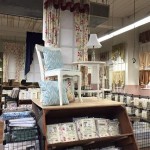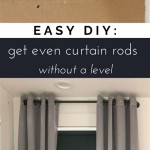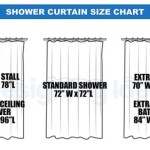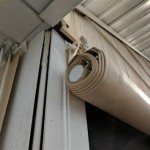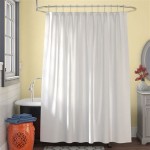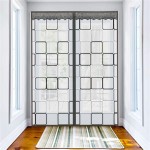Ways to Tie Curtains Back: Enhancing Light, Space, and Style
Curtain tie-backs serve multiple purposes, functioning not only as practical tools to control light and privacy but also as decorative elements that can significantly impact the aesthetic appeal of a room. The manner in which curtains are tied back can influence the amount of natural light entering a space, the perceived size of the window and room, and the overall style and character of the décor. There exists a wide array of methods for tying back curtains, ranging from traditional techniques to innovative and unconventional approaches. The selection of a particular method typically depends on factors such as the type of curtains, the desired level of light control, the existing décor, and personal preferences.
The placement of the tie-back is also a crucial consideration. A higher placement generally creates a more dramatic and elegant look, allowing more light to enter the room and maximizing the view outside. Conversely, a lower placement results in a more relaxed and casual appearance, partially obscuring the window and reducing the amount of light. The tightness of the tie-back also impacts the overall aesthetic. A loosely tied curtain creates soft folds and drapes, lending a romantic and airy feel to the space. A tightly tied curtain, on the other hand, results in a more structured and formal look.
Beyond purely functional and aesthetic considerations, the choice of tie-back material and style offers further opportunities for personalization and creative expression. Traditional tie-backs include cords, ropes, ribbons, and fabric sashes, while more contemporary options incorporate metal hooks, magnetic clips, and decorative hardware. The selection of materials and styles should ideally complement the existing décor and reflect the overall design theme of the room. For instance, a rustic farmhouse style might benefit from the use of natural materials such as jute rope or leather straps, while a sleek modern space might call for minimalist metal tie-backs.
Traditional Fabric Tie-backs: Versatility and Elegance
Fabric tie-backs, crafted from materials such as ribbons, sashes, or matching curtain fabric, represent a classic and versatile option for securing curtains. Their inherent adaptability allows them to seamlessly integrate into a wide range of décor styles, from traditional to contemporary. One of the primary advantages of fabric tie-backs lies in their ability to be customized to match or complement the existing curtains and other soft furnishings in the room. This cohesive look enhances the overall visual harmony and creates a sense of coordinated design.
The creation of fabric tie-backs can be a simple and cost-effective DIY project. Utilizing leftover curtain fabric or purchasing coordinating material allows for the creation of custom tie-backs that perfectly match the curtains in terms of color, texture, and pattern. The length and width of the fabric tie-back can be adjusted to suit the size and weight of the curtains, ensuring a secure and visually appealing hold. Furthermore, the flexibility of fabric allows for various tying styles, from a simple knot to an elaborate bow, adding a touch of personal flair to the window treatment.
When selecting fabric tie-backs, considerations should be given to the weight and durability of the material. Heavier fabrics, such as velvet or brocade, provide a more substantial and luxurious feel, while lighter fabrics, such as cotton or linen, offer a more casual and airy appearance. The chosen fabric should also be able to withstand repeated use and maintain its appearance over time. Reinforcing the edges of the fabric tie-back with stitching or hemming can enhance its durability and prevent fraying. The color of the tie-back should also be carefully considered. A contrasting color can create a bold visual statement, while a matching color can provide a more subtle and understated effect.
Decorative Hardware and Hooks: Adding Visual Interest
Decorative hardware tie-backs, including hooks, holdbacks, and knobs, offer a more permanent and visually striking solution for securing curtains. Unlike fabric tie-backs, which are tied around the curtains, these hardware options are typically mounted to the wall near the window, providing a stationary point for holding back the fabric. The use of decorative hardware allows for the incorporation of various design elements, such as intricate carvings, ornate finishes, and unique shapes, adding a touch of personality and visual interest to the window treatment.
The selection of decorative hardware tie-backs should be guided by the overall style and aesthetic of the room. For instance, a traditional space might benefit from the use of ornate brass or wrought iron hooks, while a modern space might call for sleek and minimalist chrome or stainless steel holdbacks. The size and scale of the hardware should also be proportional to the size of the window and the weight of the curtains. Overly large or small hardware can look out of place and detract from the overall aesthetic.
The installation of decorative hardware tie-backs typically requires drilling holes in the wall, so careful planning and accurate measurements are essential. The hardware should be positioned at a height and distance from the window that allows for the curtains to be draped gracefully and securely. It is also important to ensure that the hardware is securely mounted to the wall to prevent it from coming loose or falling down. When installing hardware on drywall, it is recommended to use wall anchors to provide additional support. Consider the hardware's projection from the wall; a shallow projection might not hold heavier curtains effectively, while a deeper projection might unnecessarily dominate the window space.
Alternative Tie-Back Methods: Innovation and Creativity
Beyond traditional fabric tie-backs and decorative hardware, a range of alternative methods exist for securing curtains, offering opportunities for innovation and creative expression. These unconventional techniques utilize everyday objects and unexpected materials to create unique and visually interesting window treatments. The exploration of alternative tie-back methods can be a fun and rewarding way to personalize a space and add a touch of individuality to the décor.
One popular alternative is the use of rope or twine as a tie-back. Natural materials such as jute or sisal can add a rustic and bohemian touch to a room, while more refined options such as silk or satin rope can create a more elegant and sophisticated look. The rope can be tied in a simple knot, braided for added texture, or adorned with decorative beads or tassels. Another creative alternative is the use of belts as tie-backs. Leather belts can add a touch of industrial chic to a space, while fabric belts can complement the colors and patterns of the curtains. The buckle of the belt can serve as a decorative accent, adding a touch of visual interest.
Other alternative tie-back methods include the use of magnetic clips, decorative chains, and even repurposed jewelry. Magnetic clips offer a convenient and damage-free way to secure curtains, while decorative chains can add a touch of glamour and sophistication. Repurposed jewelry, such as vintage brooches or necklaces, can be used to create unique and eye-catching tie-backs. When exploring alternative tie-back methods, it is important to consider the weight and texture of the curtains, as well as the overall style and aesthetic of the room. The selected method should be both functional and visually appealing, enhancing the overall design of the space. Ensuring the tie-back method is secure and won't damage the curtains is also paramount; avoid sharp edges or abrasive materials that could snag or tear the fabric.
In summary, the art of tying back curtains offers a vast landscape of possibilities, blending practicality with decorative finesse. The informed selection of materials, methods, and placement elevates window treatments from mere functionality to integral elements of interior design, shaping light, space, and style within a room.

8 Diffe Ways To Tie Back Curtains

8 Diffe Ways To Tie Back Curtains

How To Tie Curtains 10 Steps With Pictures Wikihow

How To Make Curtain Tie Backs The Easy Way

How To Tie Curtains In A Knot 9 Steps With Pictures Wikihow

8 Diffe Ways To Tie Back Curtains

Curtain Tie Back Ideas

How To Tie Curtains 10 Steps With Pictures Wikihow

Diy Curtain Tie Backs Unique Functional And Decorative Ideas Hello Sewing

8 Diffe Ways To Tie Back Curtains

